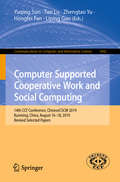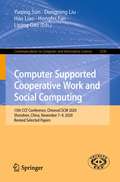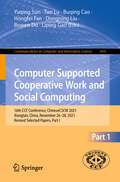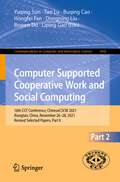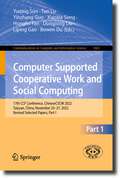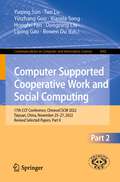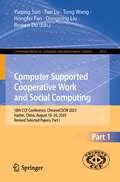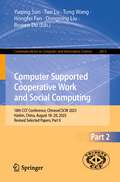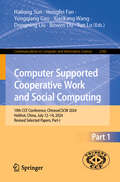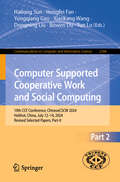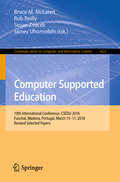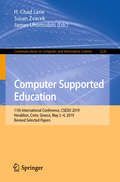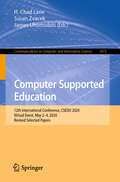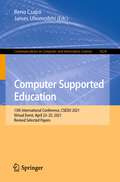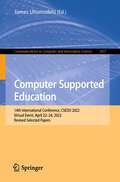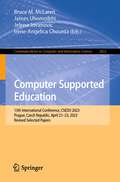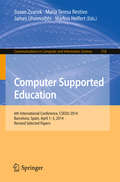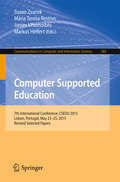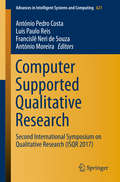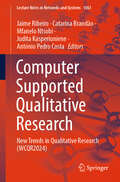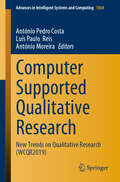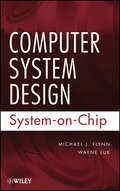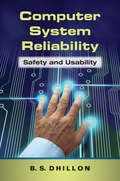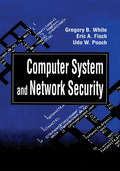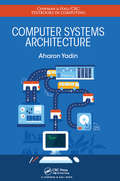- Table View
- List View
Computer Supported Cooperative Work and Social Computing: 14th CCF Conference, ChineseCSCW 2019, Kunming, China, August 16–18, 2019, Revised Selected Papers (Communications in Computer and Information Science #1042)
by Zhengtao Yu Yuqing Sun Tun Lu Liping Gao Hongfei FanThis book constitutes the refereed proceedings of the 14th CCF Conference on Computer Supported Cooperative Work and Social Computing, ChineseCSCW 2019, held in Kunming, China, in August 2019. The 52 revised full papers and 10 short papers were carefully reviewed and selected from 169 submissions. The papers of this volume are organized in topical sections on: collaborative models, approaches, algorithms, and systems; social computing (online communities, crowdsourcing, recommendation, sentiment analysis, etc.); AI for CSCW and social computing.
Computer Supported Cooperative Work and Social Computing: 15th CCF Conference, ChineseCSCW 2020, Shenzhen, China, November 7–9, 2020, Revised Selected Papers (Communications in Computer and Information Science #1330)
by Yuqing Sun Liping Gao Hongfei Fan Dongning Liu Hao LiaoThis book constitutes the refereed post-conference proceedings of the 15th CCF Conference on Computer Supported Cooperative Work and Social Computing, ChineseCSCW 2020, held in Shenzhen, China, in November 2020.The 40 revised full papers and 15 revised short papers were carefully reviewed and selected from 137 submissions. The papers of this volume are organized in topical sections on: crowdsourcing, crowd intelligence, and crowd cooperative computing; domain-specific collaborative applications; collaborative mechanisms, models, approaches, algorithms, and systems; social media and online communities; and short papers.
Computer Supported Cooperative Work and Social Computing: 16th CCF Conference, ChineseCSCW 2021, Xiangtan, China, November 26–28, 2021, Revised Selected Papers, Part I (Communications in Computer and Information Science #1491)
by Yuqing Sun Tun Lu Liping Gao Hongfei Fan Dongning Liu Buqing Cao Bowen DuThe two-volume set CCIS 1491 and 1492 constitutes the refereed post-conferenceproceedings of the 16th CCF Conference on Computer Supported Cooperative Work and Social Computing, ChineseCSCW 2021, held in Xiangtan, China, November 26–28, 2021. The conference was held in a hybrid mode i.e. online and on-site in Xiangtan due to the COVID-19 crisis.The 65 revised full papers and 22 revised short papers were carefully reviewed and selected from 242 submissions. The papers are organized in the following topical sections:Volume I:Collaborative Mechanisms, Models, Approaches, Algorithms and Systems; Cooperative Evolutionary Computation and Human-like Intelligent Collaboration; Domain-Specific Collaborative Applications;Volume II: Crowd Intelligence and Crowd Cooperative Computing; Social Media and Online Communities.
Computer Supported Cooperative Work and Social Computing: 16th CCF Conference, ChineseCSCW 2021, Xiangtan, China, November 26–28, 2021, Revised Selected Papers, Part II (Communications in Computer and Information Science #1492)
by Yuqing Sun Tun Lu Liping Gao Hongfei Fan Dongning Liu Buqing Cao Bowen DuThe two-volume set CCIS 1491 and 1492 constitutes the refereed post-conferenceproceedings of the 16th CCF Conference on Computer Supported Cooperative Work and Social Computing, ChineseCSCW 2021, held in Xiangtan, China, November 26–28, 2021. The conference was held in a hybrid mode i.e. online and on-site in Xiangtan due to the COVID-19 crisis.The 65 revised full papers and 22 revised short papers were carefully reviewed and selected from 242 submissions. The papers are organized in the following topical sections:Volume I:Collaborative Mechanisms, Models, Approaches, Algorithms and Systems; Cooperative Evolutionary Computation and Human-like Intelligent Collaboration; Domain-Specific Collaborative Applications;Volume II: Crowd Intelligence and Crowd Cooperative Computing; Social Media and Online Communities.
Computer Supported Cooperative Work and Social Computing: 17th CCF Conference, ChineseCSCW 2022, Taiyuan, China, November 25–27, 2022, Revised Selected Papers, Part I (Communications in Computer and Information Science #1681)
by Yuqing Sun Tun Lu Liping Gao Hongfei Fan Dongning Liu Bowen Du Yinzhang Guo Xiaoxia SongThis two-volume set constitutes the refereed proceedings of the 17th CCF Conference on Computer Supported Cooperative Work and Social Computing, ChineseCSCW 2022 held in Taiyuan, China, during November 25–27, 2022.The 60 full papers and 30 short papers included in this two-volume set were carefully reviewed and selected from 211 submissions. They were organized in topical sections as follows: answer set programming; Social Media and Online Communities, Collaborative Mechanisms, Models, Approaches, Algorithms and Systems; Crowd Intelligence and Crowd Cooperative Computing; Cooperative Evolutionary Computation and Human-like Intelligent Collaboration; Domain-Specific Collaborative Applications.
Computer Supported Cooperative Work and Social Computing: 17th CCF Conference, ChineseCSCW 2022, Taiyuan, China, November 25–27, 2022, Revised Selected Papers, Part II (Communications in Computer and Information Science #1682)
by Yuqing Sun Tun Lu Liping Gao Hongfei Fan Dongning Liu Bowen Du Yinzhang Guo Xiaoxia SongThis two-volume set constitutes the refereed proceedings of the 17th CCF Conference on Computer Supported Cooperative Work and Social Computing, ChineseCSCW 2022 held in Datong, China, during September 23–25, 2022.The 60 full papers and 30 short papers included in this two-volume set were carefully reviewed and selected from 211 submissions. They were organized in topical sections as follows: answer set programming; Social Media and Online Communities, Collaborative Mechanisms, Models, Approaches, Algorithms and Systems; Crowd Intelligence and Crowd Cooperative Computing; Cooperative Evolutionary Computation and Human-like Intelligent Collaboration; Domain-Specific Collaborative Applications.
Computer Supported Cooperative Work and Social Computing: 18th CCF Conference, ChineseCSCW 2023, Harbin, China, August 18–20, 2023, Revised Selected Papers, Part I (Communications in Computer and Information Science #2012)
by Yuqing Sun Tun Lu Hongfei Fan Dongning Liu Bowen Du Tong WangThis two-volume set constitutes the revised selected papers of the 18th CCF Conference on Computer Supported Cooperative Work and Social Computing, ChineseCSCW 2023 held in Harbin, China, in August 2023. The 54 full papers and 28 short papers presented in these proceedings were carefully reviewed and selected from 221 submissions. The papers are organized in the following topical sections: Social Media and Online Communities; Collaborative Mechanisms, Models, Approaches, Algorithms and Systems; Crowd Intelligence and Crowd Cooperative Computing; Cooperative Evolutionary Computation and Human-like Intelligent Collaboration; Domain-Specific Collaborative Applications.
Computer Supported Cooperative Work and Social Computing: 18th CCF Conference, ChineseCSCW 2023, Harbin, China, August 18–20, 2023, Revised Selected Papers, Part II (Communications in Computer and Information Science #2013)
by Yuqing Sun Tun Lu Hongfei Fan Dongning Liu Bowen Du Tong WangThis two-volume set constitutes the revised selected papers of the 18th CCF Conference on Computer Supported Cooperative Work and Social Computing, ChineseCSCW 2023 held in Harbin, China, in August 2023. The 54 full papers and 28 short papers presented in these proceedings were carefully reviewed and selected from 221 submissions. The papers are organized in the following topical sections: Social Media and Online Communities; Collaborative Mechanisms, Models, Approaches, Algorithms and Systems; Crowd Intelligence and Crowd Cooperative Computing; Cooperative Evolutionary Computation and Human-like Intelligent Collaboration; Domain-Specific Collaborative Applications.
Computer Supported Cooperative Work and Social Computing: 19th CCF Conference, ChineseCSCW 2024, Hohhot, China, July 12–14, 2024, Revised Selected Papers, Part I (Communications in Computer and Information Science #2343)
by Tun Lu Hongfei Fan Dongning Liu Bowen Du Hailong Sun Yongqiang Gao Xiaokang WangThis two part LNCS volumes constitutes the refereed proceedings of the 19th CCF Conference on Computer Supported Cooperative Work and Social Computing, ChineseCSCW 2024, held in Hohhot, China, in July 12-14, 2024. The 52 full papers and 18 short papers included in this book were carefully reviewed and selected from 200 submissions. They were organized in topical sections as follows : Part-I : Trend; CSCW and Social Computing, and Human-Machine-Things Fusion and Human-AI Collaborative Computing. Part-II : Crowd Cooperative Computing and Evolutionary Computation, and Collaborative Data, Software and Services.
Computer Supported Cooperative Work and Social Computing: 19th CCF Conference, ChineseCSCW 2024, Hohhot, China, July 12–14, 2024, Revised Selected Papers, Part II (Communications in Computer and Information Science #2344)
by Tun Lu Hongfei Fan Dongning Liu Bowen Du Hailong Sun Yongqiang Gao Xiaokang WangThis two part LNCS volumes constitutes the refereed proceedings of the 19th CCF Conference on Computer Supported Cooperative Work and Social Computing, ChineseCSCW 2024, held in Hohhot, China, in July 12- 14, 2024. The 52 full papers and 18 short papers included in this book were carefully reviewed and selected from 200 submissions. They were organized in topical sections as follows : Part-I : Trend; CSCW and Social Computing, and Human-Machine-Things Fusion and Human-AI Collaborative Computing. Part-II : Crowd Cooperative Computing and Evolutionary Computation, and Collaborative Data, Software and Services.
Computer Supported Education: 10th International Conference, CSEDU 2018, Funchal, Madeira, Portugal, March 15–17, 2018, Revised Selected Papers (Communications in Computer and Information Science #1022)
by Susan Zvacek James Uhomoibhi Bruce M. McLaren Rob ReillyThis book constitutes the thoroughly refereed proceedings of the 9th International Conference on Computer Supported Education, CSEDU 2018, held in Funchal, Madeira, Portugal, in March 2018. The 27 revised full papers were carefully reviewed and selected from 193 submissions. The papers deal with the following topics: new educational environments, best practices and case studies of innovative technology-based learning strategies, institutional policies on computer-supported education including open and distance education.
Computer Supported Education: 11th International Conference, CSEDU 2019, Heraklion, Crete, Greece, May 2-4, 2019, Revised Selected Papers (Communications in Computer and Information Science #1220)
by Susan Zvacek James Uhomoibhi H. Chad LaneThis book constitutes the thoroughly refereed proceedings of the 11th International Conference on Computer Supported Education, CSEDU 2019, held in Heraklion, Crete, Greece, in May 2019. The 30 revised full papers were carefully reviewed and selected from 202 submissions. The papers cover wide research fields including authoring tools and content development, AV-communication and multimedia, classroom management, e-Learning hardware and software, blended learning, critical success factors in distance learning.
Computer Supported Education: 12th International Conference, CSEDU 2020, Virtual Event, May 2–4, 2020, Revised Selected Papers (Communications in Computer and Information Science #1473)
by Susan Zvacek James Uhomoibhi H. Chad LaneThis book constitutes selected, revised and extended papers from the 12th International Conference on Computer Supported Education, CSEDU 2020, held as a virtual event in May 2020. The 25 revised full papers were carefully reviewed and selected from 190 submissions. The presented papers contribute to the understanding of relevant trends of current research on Computer Supported Education, including learning analytics, intelligent tutoring systems, virtual and augmented reality, MOOCs, and automated assessment systems.
Computer Supported Education: 13th International Conference, CSEDU 2021, Virtual Event, April 23–25, 2021, Revised Selected Papers (Communications in Computer and Information Science #1624)
by James Uhomoibhi Beno CsapóThis book constitutes selected, revised and extended papers from the 13th International Conference on Computer Supported Education, CSEDU 2021, held as a virtual event in April 2021.The 27 revised full papers were carefully reviewed and selected from 143 submissions. They were organized in topical sections as follows: artificial intelligence in education; information technologies supporting learning; learning/teaching methodologies and assessment; social context and learning environments; ubiquitous learning; current topics.
Computer Supported Education: 14th International Conference, CSEDU 2022, Virtual Event, April 22–24, 2022, Revised Selected Papers (Communications in Computer and Information Science #1817)
by James UhomoibhiThis book constitutes the refereed post-proceedings of the 14th International Conference on Computer Supported Education, CSEDU 2022, Virtual Event, April 22–24, 2022. The conference was held virtually due to the COVID-19 crisis.The 8 full papers included in this book were carefully reviewed and selected from 181 submissions. The papers included in CSEDU 2022 proceedings contribute to the understanding of relevant trends of current research on Computer Supported Education, including: Emerging Technologies in Education for Sustainable Development, Instructional Design, Pre-K/K-12 Education, Machine Learning, Learning with AI Systems, Higher Order Thinking Skills, Game-Based and Simulation-Based Learning, Educational Data Mining, Course Design and eLearning Curriculae and Constructivism and Social Constructivism.
Computer Supported Education: 15th International Conference, CSEDU 2023, Prague, Czech Republic, April 21–23, 2023, Revised Selected Papers (Communications in Computer and Information Science #2052)
by James Uhomoibhi Bruce M. McLaren Irene-Angelica Chounta Jelena JovanovicThis book constitutes revised selected papers from the 15th International Conference on Computer Supported Education, CSEDU 2023, which took place in Prague, Czech Republic, during April 21–23, 2023.CSEDU 2023 accepted 34 full and 54 papers out of 162 papers submissions. Out of these, 8 contributions have been selected for inclusion in this book. The papers included in this book contribute to the understanding of relevant trends in the current research on Computer Supported Education, with a particular focus on: eLearning Platforms, Portals, Feedback and Learning Support, Game-Based and Simulation-Based Learning, Active Learning, Tools to Assess Learning, Learning with AI Systems, Higher Order Thinking Skills, Flipped Classroom, Faculty Development and Constructivism and Social Constructivism.
Computer Supported Education: 6th International Conference, CSEDU 2014, Barcelona, Spain, April 1-3, 2014, Revised Selected Papers (Communications in Computer and Information Science #510)
by Susan Zvacek Markus Helfert Maria Teresa Restivo James UhomoibhiThis book constitutes the refereed proceedings of the 6th International Conference on Computer Supported Education, CSEDU 2014, held in Barcelona, Spain, in April 2014. The 24 revised full papers presented were carefully reviewed and selected from 242 submissions. The papers address topics such as information technologies supporting learning; learning/teaching methodologies and assessment; social context and learning environments; domain applications and case studies; and ubiquitous learning.
Computer Supported Education: 7th International Conference, CSEDU 2015, Lisbon, Portugal, May 23-25, 2015, Revised Selected Papers (Communications in Computer and Information Science #583)
by Susan Zvacek Markus Helfert Maria Teresa Restivo James UhomoibhiThis book constitutes the refereed proceedings of the 6th International Conference on Computer Supported Education, CSEDU 2014, held in Barcelona, Spain, in April 2014. The 24 revised full papers presented were carefully reviewed and selected from 242 submissions. The papers address topics such as information technologies supporting learning; learning/teaching methodologies and assessment; social context and learning environments; domain applications and case studies; and ubiquitous learning.
Computer Supported Qualitative Research
by António Moreira Luís Paulo Reis António Pedro Costa Francislê Neri SouzaThis book includes a selection of the articles accepted for presentation and discussion at the second International Symposium on Qualitative Research (ISQR2017), held in Salamanca, Spain, July 12-14, 2017. ISQR2017 is part of the Iberian-American Congress on Qualitative Research (CIAIQ), and featured four main application fields (Education, Health, Social Sciences, and Engineering and Technology) and seven main subjects: Rationale and Paradigms of Qualitative Research; Systematization of approaches with Qualitative Studies; Qualitative and Mixed Methods Research; Data Analysis Types; Innovative Processes of Qualitative Data Analysis; Qualitative Research in Web Contexts; Qualitative Analysis with the Support of Specific Software. This book is a valuable resource for academics, researchers, teachers and students who need information on the above topics, as well as on the use of Computer Assisted Qualitative Data AnalysiS (CAQDAS).
Computer Supported Qualitative Research: New Trends in Qualitative Research (WCQR2024) (Lecture Notes in Networks and Systems #1061)
by António Pedro Costa Jaime Ribeiro Catarina Brandão Mfanelo Ntsobi Judita KasperiunieneThis book aims to bring together researchers, academics, and professionals, promoting the sharing and discussing knowledge, new perspectives, experiences, and innovations in Qualitative Research. This book includes selecting the articles accepted for presentation and discussion at WCQR2024, held January 23 to 25, 2024 (face-to-face and virtual conference). WCQR2024 featured four main application fields (Education, Health, Social Sciences, and Engineering/Technology) and seven main subjects: Rationale and Paradigms of Qualitative Research; Systematization of Approaches with Qualitative Studies; Qualitative and Mixed Methods Research; Data Analysis Types; Innovative Processes of Qualitative Data Analysis; Qualitative Research in Web Context; Qualitative Analysis with Software Support. The book is valuable for everyone interested in qualitative research, emphasizing Computer-Assisted Qualitative Data Analysis Software (CAQDAS).
Computer Supported Qualitative Research: New Trends on Qualitative Research (WCQR2019) (Advances in Intelligent Systems and Computing #1068)
by António Moreira Luís Paulo Reis António Pedro CostaThe World Conference on Qualitative Research (WCQR) is an annual event that aims to bring together researchers, academics and professionals, promoting the sharing and discussion of knowledge, new perspectives, experiences and innovations on the field of Qualitative Research. This book includes a selection of the articles accepted for presentation and discussion at WCQR2019, held in Porto, Portugal, October 16-18, 2019. WCQR2019 featured four main application fields (Education, Health, Social Sciences, and Engineering/Technology) and seven main subjects: Rationale and Paradigms of Qualitative Research; Systematization of Approaches with Qualitative Studies; Qualitative and Mixed Methods Research; Data Analysis Types; Innovative Processes of Qualitative Data Analysis; Qualitative Research in Web Context; Qualitative Analysis with Software Support. The book is a valuable resource for everyone interested in Qualitative Research with emphasis on Computer Assisted Qualitative Data Analysis.
Computer System Design
by Wayne Luk Michael J. FlynnThe next generation of computer system designers will be less concerned about details of processors and memories, and more concerned about the elements of a system tailored to particular applications. These designers will have a fundamental knowledge of processors and other elements in the system, but the success of their design will depend on the skills in making system-level tradeoffs that optimize the cost, performance and other attributes to meet application requirements. This book provides a new treatment of computer system design, particularly for System-on-Chip (SOC), which addresses the issues mentioned above. It begins with a global introduction, from the high-level view to the lowest common denominator (the chip itself), then moves on to the three main building blocks of an SOC (processor, memory, and interconnect). Next is an overview of what makes SOC unique (its customization ability and the applications that drive it). The final chapter presents future challenges for system design and SOC possibilities.
Computer System Reliability: Safety and Usability
by B.S. DhillonComputer systems have become an important element of the world economy, with billions of dollars spent each year on development, manufacture, operation, and maintenance. Combining coverage of computer system reliability, safety, usability, and other related topics into a single volume, Computer System Reliability: Safety and Usability eliminates th
Computer System and Network Security (Computer Science & Engineering #7)
by Gregory B. White Eric A. Fisch Udo W. PoochComputer System and Network Security provides the reader with a basic understanding of the issues involved in the security of computer systems and networks. Introductory in nature, this important new book covers all aspects related to the growing field of computer security. Such complete coverage in a single text has previously been unavailable, and college professors and students, as well as professionals responsible for system security, will find this unique book a valuable source of information, either as a textbook or as a general reference. Computer System and Network Security discusses existing and potential threats to computer systems and networks and outlines the basic actions that are generally taken to protect them. The first two chapters of the text introduce the reader to the field of computer security, covering fundamental issues and objectives. The next several chapters describe security models, authentication issues, access control, intrusion detection, and damage control. Later chapters address network and database security and systems/networks connected to wide-area networks and internetworks. Other topics include firewalls, cryptography, malicious software, and security standards. The book includes case studies with information about incidents involving computer security, illustrating the problems and potential damage that can be caused when security fails.This unique reference/textbook covers all aspects of computer and network security, filling an obvious gap in the existing literature.
Computer Systems Architecture (Chapman & Hall/CRC Textbooks in Computing)
by Aharon YadinComputer Systems Architecture provides IT professionals and students with the necessary understanding of computer hardware. It addresses the ongoing issues related to computer hardware and discusses the solutions supplied by the industry. The book describes trends in computing solutions that led to the current available infrastructures, tracing the initial need for computers to recent concepts such as the Internet of Things. It covers computers’ data representation, explains how computer architecture and its underlying meaning changed over the years, and examines the implementations and performance enhancements of the central processing unit (CPU). It then discusses the organization, hierarchy, and performance considerations of computer memory as applied by the operating system and illustrates how cache memory significantly improves performance. The author proceeds to explore the bus system, algorithms for ensuring data integrity, input and output (I/O) components, methods for performing I/O, various aspects relevant to software engineering, and nonvolatile storage devices, such as hard drives and technologies for enhancing performance and reliability. He also describes virtualization and cloud computing and the emergence of software-based systems’ architectures. Accessible to software engineers and developers as well as students in IT disciplines, this book enhances readers’ understanding of the hardware infrastructure used in software engineering projects. It enables readers to better optimize system usage by focusing on the principles used in hardware systems design and the methods for enhancing performance.
